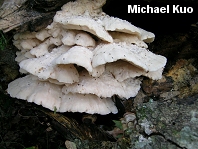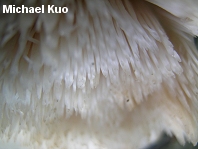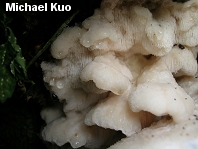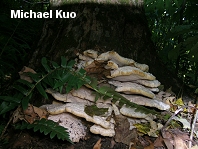| Major Groups > Toothed Mushrooms > Climacodon septentrionalis |

|
Climacodon septentrionalis [ Basidiomycetes > Polyporales > Meruliaceae > Climacodon . . . ] by Michael Kuo Climacodon septentrionalis is usually impressive, forming massive clusters that can be seen from many yards away. At this distance it looks like a polypore, growing on dead hardwoods or from the wounds of living trees. But while it is officially in the order Polyporales, it has teeth on its underside, rather than pores, and is usually treated with the toothed mushrooms. The fruiting bodies of Climacodon septentrionalis are extremely durable and can last for many weeks--long enough, in fact, that the caps of old specimens often begin to take on a greenish hue as a result of colonizing algae. The mushroom is parasitic, causing a heartwood rot, and is especially fond of sugar maple and beech; it is frequently found growing from the wounds of these trees, high above the ground. Climacodon septentrionale is the name used by some authors. Steccherinum septentrionale is a synonym. Description: Ecology: Parasitic on hardwoods, especially green ash, sugar maple, and beech; growing in large shelf-like clusters in the wounds of living trees, or on recently dead stumps or trunks; summer and fall; northeastern North America, south to Kentucky and Tennessee and west to the Great Plains. Caps: Up to 30 cm across and 5 cm thick at the base; convex, flat, or shallowly depressed; kidney-shaped or semicircular in outline; sticky or dry; hairy or roughened; whitish, becoming yellowish with age; sometimes with fine concentric zones of texture. Undersurface: Spines 1-2.5 cm long; tightly packed; white at first, becoming yellowish with age. Stem: Absent, but caps often share a whitish basal plate. Flesh: White; tough; unchanging when sliced; zoned. Odor and Taste: Taste mild when young, but bitter or unpleasant in age; odor not distinctive, becoming foul with age. Spore Print: White. Microscopic Features: Spores 4.5-5 x 2-2.5 µ; smooth; ellipsoid; inamyloid. Cystidia fusoid to mucronate; thick-walled; often encrusted. Hyphal system monomitic. Clamp connections present. REFERENCES: (Fries, 1821) Karsten, 1881. (Saccardo, 1888; Maas Geesteranus, 1971; Smith, Smith & Weber, 1981; Koski-Kotiranta & Niemelä, 1987; Phillips, 1991/2005; Lincoff, 1992; Barron, 1999; Roody, 2003; McNeil, 2006; Miller & Miller, 2006; Binion et al., 2008.) Herb. Kuo 09300404. This site contains no information about the edibility or toxicity of mushrooms. |
© MushroomExpert.Com |
|
Cite this page as: Kuo, M. (2010, May). Climacodon septentrionalis. Retrieved from the MushroomExpert.Com Web site: http://www.mushroomexpert.com/climacodon_septentrionalis.html |



